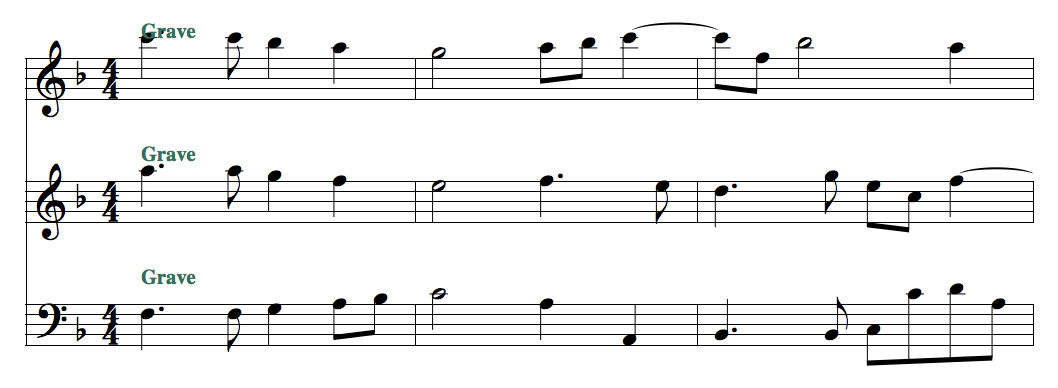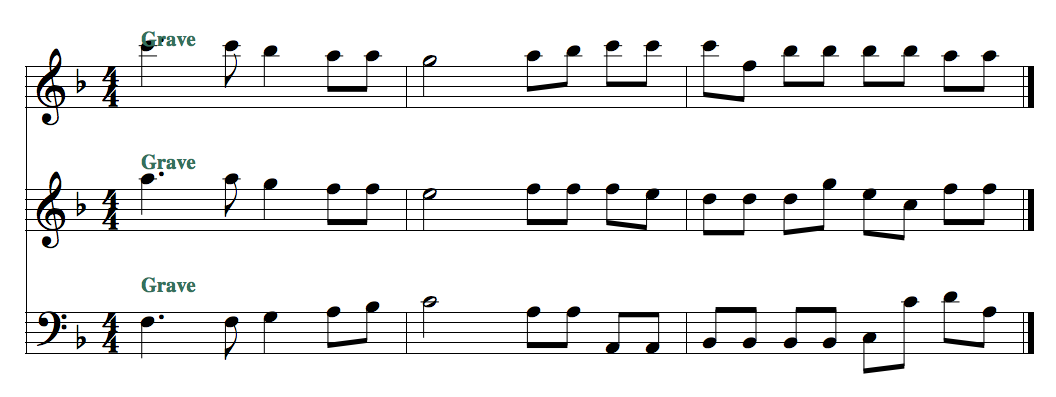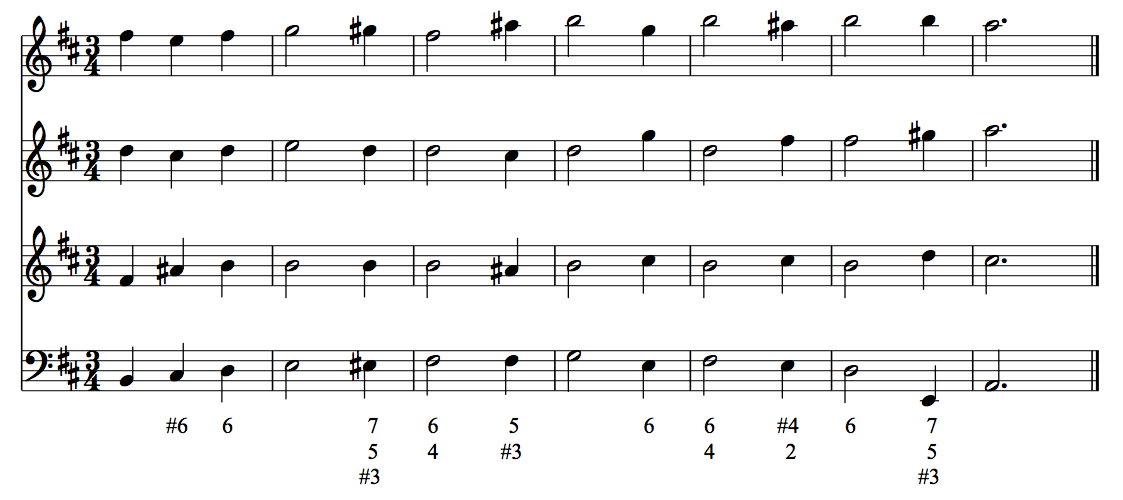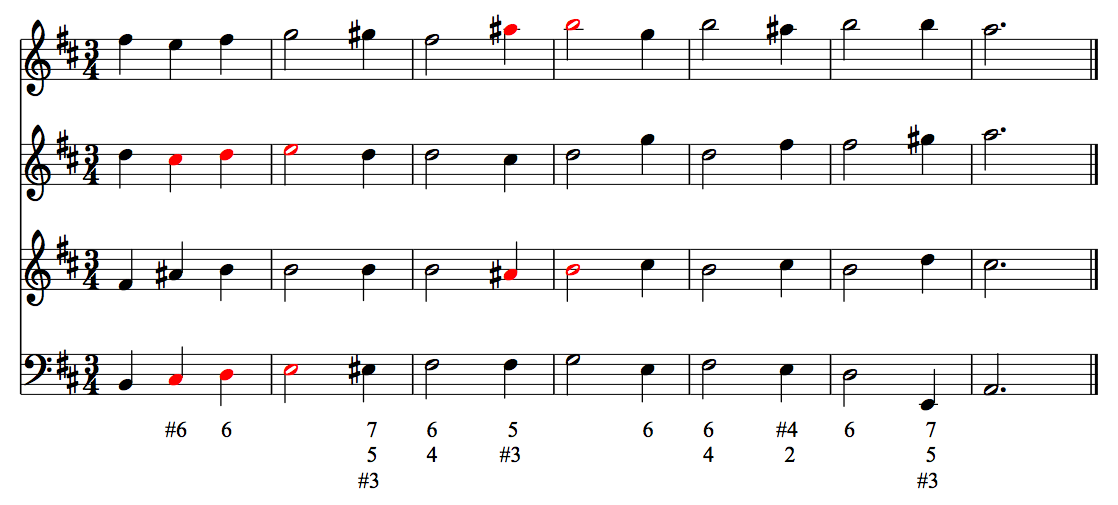music21.figuredBass.checker¶
Functions¶
- music21.figuredBass.checker.extractHarmonies(music21Stream)¶
Takes in a
Streamand returns a dictionary whose values are the voice leading moments of theStreamand whose keys are (offset, endTime) pairs delimiting their duration. The voice leading moments are spelled out from the first or highestPartto the lowest one.>>> score = corpus.parse('corelli/opus3no1/1grave').measures(1, 3) >>> score.show()

>>> from music21.figuredBass import checker >>> allHarmonies = checker.extractHarmonies(score) >>> for (offsets, notes) in sorted(allHarmonies.items()): ... print('{0!s:15}[{1!s:23}{2!s:23}{3!s:22}]'.format(offsets, notes[0], notes[1], notes[2])) (0.0, 1.5) [<music21.note.Note C> <music21.note.Note A> <music21.note.Note F> ] (1.5, 2.0) [<music21.note.Note C> <music21.note.Note A> <music21.note.Note F> ] (2.0, 3.0) [<music21.note.Note B-> <music21.note.Note G> <music21.note.Note G> ] (3.0, 3.5) [<music21.note.Note A> <music21.note.Note F> <music21.note.Note A> ] (3.5, 4.0) [<music21.note.Note A> <music21.note.Note F> <music21.note.Note B->] (4.0, 6.0) [<music21.note.Note G> <music21.note.Note E> <music21.note.Note C> ] (6.0, 6.5) [<music21.note.Note A> <music21.note.Note F> <music21.note.Note A> ] (6.5, 7.0) [<music21.note.Note B-> <music21.note.Note F> <music21.note.Note A> ] (7.0, 7.5) [<music21.note.Note C> <music21.note.Note F> <music21.note.Note A> ] (7.5, 8.0) [<music21.note.Note C> <music21.note.Note E> <music21.note.Note A> ] (8.0, 8.5) [<music21.note.Note C> <music21.note.Note D> <music21.note.Note B->] (8.5, 9.0) [<music21.note.Note F> <music21.note.Note D> <music21.note.Note B->] (9.0, 9.5) [<music21.note.Note B-> <music21.note.Note D> <music21.note.Note B->] (9.5, 10.0) [<music21.note.Note B-> <music21.note.Note G> <music21.note.Note B->] (10.0, 10.5) [<music21.note.Note B-> <music21.note.Note E> <music21.note.Note C> ] (10.5, 11.0) [<music21.note.Note B-> <music21.note.Note C> <music21.note.Note C> ] (11.0, 11.5) [<music21.note.Note A> <music21.note.Note F> <music21.note.Note D> ] (11.5, 12.0) [<music21.note.Note A> <music21.note.Note F> <music21.note.Note A> ]
- music21.figuredBass.checker.getVoiceLeadingMoments(music21Stream)¶
Takes in a
Streamand returns aScoreof theStreambroken up into its voice leading moments.>>> score = corpus.parse('corelli/opus3no1/1grave').measures(1, 3) >>> score.show()

>>> from music21.figuredBass import checker >>> vlMoments = checker.getVoiceLeadingMoments(score) >>> vlMoments.show()

- music21.figuredBass.checker.checkConsecutivePossibilities(music21Stream, functionToApply, color='#FF0000', debug=False)¶
Takes in a
Scoreand a functionToApply which takes in two consecutive possibility instances, each a tuple with pitches or rests comprising a vertical sonority. Changes the color of notes in theScorewhich comprise rule violations as determined by functionToApply.Note
Colored notes are NOT supported in Finale.
>>> music21Stream = corpus.parse('theoryExercises/checker_demo.xml') >>> music21Stream.show()

>>> from music21.figuredBass import checker >>> functionToApply = checker.parallelOctaves >>> checker.checkConsecutivePossibilities(music21Stream, functionToApply, debug=True) Function To Apply: parallelOctaves (Offset A, End Time A): (Offset B, End Time B): Part Numbers: (1.0, 2.0) (2.0, 3.0) (2, 4) (2.0, 3.0) (3.0, 5.0) (2, 4) (8.0, 9.0) (9.0, 11.0) (1, 3)
Parallel octaves can be found in the first measure, between the first two measures, and between the third and the fourth measure. The notes in question are highlighted in the music21Stream, as shown below.
>>> music21Stream.show()

- music21.figuredBass.checker.checkSinglePossibilities(music21Stream, functionToApply, color='#FF0000', debug=False)¶
Takes in a
Scoreand a functionToApply which takes in a possibility instance, a tuple with pitches or rests comprising a vertical sonority. Changes the color of notes in theScorewhich comprise rule violations as determined by functionToApply.Note
Colored notes are NOT supported in Finale.
>>> music21Stream = corpus.parse('corelli/opus3no1/1grave').measures(1, 6) >>> music21Stream.show()

>>> from music21.figuredBass import checker >>> functionToApply = checker.voiceCrossing >>> checker.checkSinglePossibilities(music21Stream, functionToApply, debug=True) Function To Apply: voiceCrossing (Offset, End Time): Part Numbers: (16.0, 16.5) (1, 2) (16.5, 17.0) (1, 2)
Voice Crossing is present in the fifth measure between the first and second voices, and the notes in question are highlighted in the music21Stream.
>>> music21Stream.show()

- music21.figuredBass.checker.correlateHarmonies(currentMapping, music21Part)¶
Adds a new
Partto an existing offset mapping.>>> from music21.figuredBass import checker >>> score = corpus.parse('corelli/opus3no1/1grave').measures(1, 3) >>> v0 = score[0] >>> offsetMapping = checker.createOffsetMapping(v0) >>> v1 = score[1] >>> newMapping = checker.correlateHarmonies(offsetMapping, v1) >>> for (offsets, notes) in sorted(newMapping.items()): ... print('{0!s:15}[{1!s:23}{2!s:21}]'.format(offsets, notes[0], notes[1])) (0.0, 1.5) [<music21.note.Note C> <music21.note.Note A>] (1.5, 2.0) [<music21.note.Note C> <music21.note.Note A>] (2.0, 3.0) [<music21.note.Note B-> <music21.note.Note G>] (3.0, 4.0) [<music21.note.Note A> <music21.note.Note F>] (4.0, 6.0) [<music21.note.Note G> <music21.note.Note E>] (6.0, 6.5) [<music21.note.Note A> <music21.note.Note F>] (6.5, 7.0) [<music21.note.Note B-> <music21.note.Note F>] (7.0, 7.5) [<music21.note.Note C> <music21.note.Note F>] (7.5, 8.0) [<music21.note.Note C> <music21.note.Note E>] (8.0, 8.5) [<music21.note.Note C> <music21.note.Note D>] (8.5, 9.0) [<music21.note.Note F> <music21.note.Note D>] (9.0, 9.5) [<music21.note.Note B-> <music21.note.Note D>] (9.5, 10.0) [<music21.note.Note B-> <music21.note.Note G>] (10.0, 10.5) [<music21.note.Note B-> <music21.note.Note E>] (10.5, 11.0) [<music21.note.Note B-> <music21.note.Note C>] (11.0, 12.0) [<music21.note.Note A> <music21.note.Note F>]
- music21.figuredBass.checker.createOffsetMapping(music21Part)¶
Creates an initial offset mapping of a
Part.>>> from music21.figuredBass import checker >>> score = corpus.parse('corelli/opus3no1/1grave').measures(1, 3) >>> v0 = score[0] >>> offsetMapping = checker.createOffsetMapping(v0) >>> for (offsets, notes) in sorted(offsetMapping.items()): ... print('{0!s:15}[{1!s:22}]'.format(offsets, notes[0])) (0.0, 1.5) [<music21.note.Note C> ] (1.5, 2.0) [<music21.note.Note C> ] (2.0, 3.0) [<music21.note.Note B->] (3.0, 4.0) [<music21.note.Note A> ] (4.0, 6.0) [<music21.note.Note G> ] (6.0, 6.5) [<music21.note.Note A> ] (6.5, 7.0) [<music21.note.Note B->] (7.0, 8.0) [<music21.note.Note C> ] (8.0, 8.5) [<music21.note.Note C> ] (8.5, 9.0) [<music21.note.Note F> ] (9.0, 11.0) [<music21.note.Note B->] (11.0, 12.0) [<music21.note.Note A> ]
- music21.figuredBass.checker.generalNoteToPitch(music21GeneralNote)¶
Takes a
GeneralNote. If it is aNote, returns its pitch. Otherwise, returns the string “RT”, a rest placeholder.>>> n1 = note.Note('G5') >>> c1 = chord.Chord(['C3', 'E3', 'G3'])
>>> figuredBass.checker.generalNoteToPitch(n1) <music21.pitch.Pitch G5> >>> figuredBass.checker.generalNoteToPitch(c1) 'RT'
Returns a list with a (highestPart, lowestPart) pair which represents a hidden fifth between shared outer parts of possibA and possibB. The outer parts here are the first and last elements of each possibility.
If sopranoPitchA and bassPitchA in possibA move to a sopranoPitchB and bassPitchB in possibB in similar motion, and the simple interval between sopranoPitchB and bassPitchB is that of a perfect fifth, then this constitutes a hidden octave between the two possibilities.
>>> from music21.figuredBass import checker >>> C3 = pitch.Pitch('C3') >>> D3 = pitch.Pitch('D3') >>> E3 = pitch.Pitch('E3') >>> F3 = pitch.Pitch('F3') >>> E5 = pitch.Pitch('E5') >>> A5 = pitch.Pitch('A5')
Here, the bass part moves up from C3 to D3 and the soprano part moves up from E5 to A5. The simple interval between D3 and A5 is a perfect fifth. Therefore, there is a hidden fifth between the two possibilities.
>>> possibA1 = (E5, E3, C3) >>> possibB1 = (A5, F3, D3) >>> checker.hiddenFifth(possibA1, possibB1) [(1, 3)]
Here, the soprano and bass parts also move in similar motion, but the simple interval between D3 and Ab5 is a diminished fifth. Consequently, there is no hidden fifth.
>>> Ab5 = pitch.Pitch('A-5') >>> possibA2 = (E5, E3, C3) >>> possibB2 = (Ab5, F3, D3) >>> checker.hiddenFifth(possibA2, possibB2) []
Now, we have the soprano and bass parts again moving to A5 and D3, whose simple interval is a perfect fifth. However, the bass moves up while the soprano moves down. Therefore, there is no hidden fifth.
>>> E6 = pitch.Pitch('E6') >>> possibA3 = (E6, E3, C3) >>> possibB3 = (A5, F3, D3) >>> checker.hiddenFifth(possibA3, possibB3) []
Returns a list with a (highestPart, lowestPart) pair which represents a hidden octave between shared outer parts of possibA and possibB. The outer parts here are the first and last elements of each possibility.
If sopranoPitchA and bassPitchA in possibA move to a sopranoPitchB and bassPitchB in possibB in similar motion, and the simple interval between sopranoPitchB and bassPitchB is that of a perfect octave, then this constitutes a hidden octave between the two possibilities.
>>> from music21.figuredBass import checker >>> C3 = pitch.Pitch('C3') >>> D3 = pitch.Pitch('D3') >>> E3 = pitch.Pitch('E3') >>> F3 = pitch.Pitch('F3') >>> A5 = pitch.Pitch('A5') >>> D6 = pitch.Pitch('D6')
Here, the bass part moves up from C3 to D3 and the soprano part moves up from A5 to D6. The simple interval between D3 and D6 is a perfect octave. Therefore, there is a hidden octave between the two possibilities.
>>> possibA1 = (A5, E3, C3) >>> possibB1 = (D6, F3, D3) # Perfect octave between soprano and bass. >>> checker.hiddenOctave(possibA1, possibB1) [(1, 3)]
Here, the bass part moves up from C3 to D3 but the soprano part moves down from A6 to D6. There is no hidden octave since the parts move in contrary motion.
>>> A6 = pitch.Pitch('A6') >>> possibA2 = (A6, E3, C3) >>> possibB2 = (D6, F3, D3) >>> checker.hiddenOctave(possibA2, possibB2) []
- music21.figuredBass.checker.parallelFifths(possibA, possibB)¶
Returns a list of (partNumberA, partNumberB) pairs, each representing two voices which form parallel fifths.
If pitchA1 and pitchA2 in possibA are separated by a simple interval of a perfect fifth, and they move to a pitchB1 and pitchB2 in possibB also separated by the simple interval of a perfect fifth, then this constitutes parallel fifths between these two parts.
>>> from music21.figuredBass import checker >>> C3 = pitch.Pitch('C3') >>> D3 = pitch.Pitch('D3') >>> G3 = pitch.Pitch('G3') >>> A3 = pitch.Pitch('A3') >>> A4 = pitch.Pitch('A4') >>> B4 = pitch.Pitch('B4')
Here, the bass moves from C3 to D3 and the tenor moves from G3 to A3. The interval between C3 and G3, as well as between D3 and A3, is a perfect fifth. These two parts, and therefore the two possibilities, have parallel fifths.
>>> possibA1 = (B4, G3, C3) >>> possibB1 = (A4, A3, D3) >>> checker.parallelFifths(possibA1, possibB1) [(2, 3)]
Now, the tenor moves instead to F3. The interval between D3 and F3 is a minor third. The bass and tenor parts don’t form parallel fifths. The soprano part forms parallel fifths with neither the bass nor tenor parts. The two possibilities, therefore, have no parallel fifths.
>>> F3 = pitch.Pitch('F3') >>> possibA2 = (B4, G3, C3) >>> possibB2 = (A4, F3, D3) >>> checker.parallelFifths(possibA2, possibB2) []
- music21.figuredBass.checker.parallelOctaves(possibA, possibB)¶
Returns a list of (partNumberA, partNumberB) pairs, each representing two voices which form parallel octaves.
If pitchA1 and pitchA2 in possibA are separated by a simple interval of a perfect octave, and they move to a pitchB1 and pitchB2 in possibB also separated by the simple interval of a perfect octave, then this constitutes parallel octaves between these two parts.
>>> from music21.figuredBass import checker >>> C3 = pitch.Pitch('C3') >>> D3 = pitch.Pitch('D3') >>> G3 = pitch.Pitch('G3') >>> A3 = pitch.Pitch('A3') >>> C4 = pitch.Pitch('C4') >>> D4 = pitch.Pitch('D4')
Here, the soprano moves from C4 to D4 and the bass moves from C3 to D3. The interval between C3 and C4, as well as between D3 and D4, is a parallel octave. The two parts, and therefore the two possibilities, have parallel octaves.
>>> possibA1 = (C4, G3, C3) >>> possibB1 = (D4, A3, D3) >>> checker.parallelOctaves(possibA1, possibB1) [(1, 3)]
Now, the soprano moves down to B3. The interval between D3 and B3 is a major sixth. The soprano and bass parts no longer have parallel octaves. The tenor part forms a parallel octave with neither the bass nor soprano, so the two possibilities do not have parallel octaves. (Notice, however, the parallel fifth between the bass and tenor!)
>>> B3 = pitch.Pitch('B3') >>> possibA2 = (C4, G3, C3) >>> possibB2 = (B3, A3, D3) >>> checker.parallelOctaves(possibA2, possibB2) []
- music21.figuredBass.checker.voiceCrossing(possibA)¶
Returns a list of (partNumberA, partNumberB) pairs, each representing two voices which form a voice crossing. The parts from the lowest part to the highest part (right to left) must correspond to increasingly higher pitches in order for there to be no voice crossing. Comparisons between pitches are done using pitch comparison methods, which are based on pitch space values (see
Pitch).>>> from music21.figuredBass import checker >>> C4 = pitch.Pitch('C4') >>> E4 = pitch.Pitch('E4') >>> C5 = pitch.Pitch('C5') >>> G5 = pitch.Pitch('G5') >>> possibA1 = (C5, G5, E4) >>> checker.voiceCrossing(possibA1) # G5 > C5 [(1, 2)] >>> possibA2 = (C5, E4, C4) >>> checker.voiceCrossing(possibA2) []